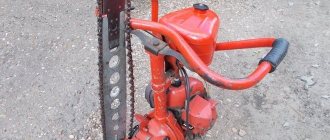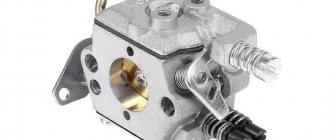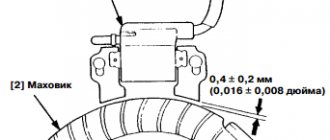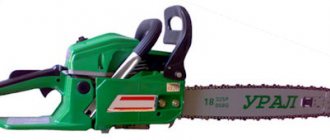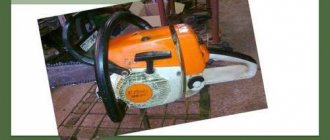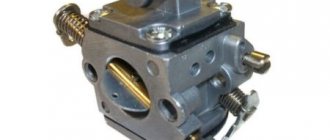When to adjust the Shtil 180 carburetor
The first step is to decide why it might be useful to adjust and repair the stihl ms 180 carburetor. What is needed, this should be done in the following cases:
- if the chainsaw does not hold idle speed;
- repairs will be required if the saw does not start;
- there is a loss of power;
- increased fuel consumption;
- the chainsaw does not develop the highest speed.
- stalls when revving up.
} the myth list is an option to continue for a long time, alas, we have determined the main prerequisites. Before you start making adjustments, you should know what main parts the carburetor on the Shtil 180 chainsaw consists of, and who makes it.
Required special tools for repair
Before starting repair work on the Shtil chainsaw, you need to prepare the necessary set of tools. A chainsaw is not a technically complex tool; to assemble and disassemble it, simple working tools that every man has on the farm are sufficient. But since the chainsaw comes from Germany, and the Germans are very pedantic people, there is a special Stihl tool for more comfortable repairs.
The Shtil multi-tool is made of high-quality hardened steel in a housing made of impact-resistant polymer. The tool is very practical and compact in size. It contains screwdrivers: a 3.50 mm slot for cleaning carburetor grooves and adjusting it, a Torx TX27 screwdriver.
Depending on the combination key model (0000 890 3401 or 129 890 3401), the tool has a set of spark plug keys from 16, , 19, respectively. The original multifunctional Shtil comes in a durable nylon case with a belt clip.
Briefly about the main thing
This model is the pride of the German manufacturer and is a specific piece of equipment created for minor work. It is used for less than 20 hours each month. This beautiful device easily helps you cope with the care of your garden and prepare firewood for the period of cold weather (see.
It must be said that these are mini-model chainsaws because they have a low weight, which is 3.9 kg, and they do not have a large tank, both oil and fuel. The manufacturer has equipped this device with a two-stroke engine with sufficient power for light work.
In addition, it is quite quiet because during operation the noise level does not exceed 98 dB. So to better understand the level of loudness itself, just compare its noise with conversational speech, which has an indicator of 76 dB.
The power of this model is 2.6 W. It's worth noting that this is a fairly significant level of power, considering that it is not a professional chainsaw. The oil tank has a volume of only 0.145 liters, and the fuel tank - 0.25 liters. The tire has a size of 350 mm and a pitch of 0.325 inches.
This model is the pride of the German manufacturer and is a straight tool designed for minor work. It can be used for a maximum of twenty hours per month. This beautiful device will help you manage the care of your garden, prepare firewood for winter (see How to cut down a tree), clear areas and become an indispensable assistant in other areas, say, simple manipulations.
We can say that this mini chainsaw model, since it has a light weight of 3.9 kg, it does not have a large tank weight, both oil and fuel. The manufacturer equips this device with a two-stroke engine with enough power for easy operation.
In addition, it is quite quiet, as the noise level does not exceed 98 dB during operation. To better understand the volume level, compare it to spoken language, which is 76 dB.
The power of this model is 2.6 W. It's worth noting that this is a pretty significant level of strength considering this is not a professional chainsaw. The oil tank has a volume of only 0.145 liters, and the fuel tank. 0.25 liters. The tire measures 350mm and has a height of 0.325 inches.
Main settings
Any candle has unique characteristics that must be taken into account when purchasing this consumable. The most important of these parameters are indicated in the instructions for the tool and in the labeling of the product itself. The main characteristics are considered to be:
- the gap that separates the electrodes;
- diameter and thread pitch;
- thread length (candle skirt or shirt);
- material from which the head electrode is made;
- heat number.
In addition, from the markings you can find out information about the manufacturing company, design features (number of electrodes), the presence of a built-in resistor and the height of the insulator.
Each of these parameters will help the owner of a tool or device with a two-stroke engine to select an adequate replacement for a failed original spark plug in cases where such a model is not available in specialized stores.
Winding device
What will you need? The stihl ms 180 carburetor is designed and manufactured by a subsidiary of Stihl, called Zama. Unique carburetors have the company logo on their body, guaranteeing product quality.
Read:
The basis of this type of model, as well as all other chainsaws, is the carburetor. But since we are talking today specifically about the Shtil 180 chainsaw, we will not deviate from the topic. So. The carburetor in this model has a single adjustment screw, that is, it is a kind of idle speed adjustment screw. While the jet of the fully loaded load is stationary.
Chainsaw carburetor Stihl 180
In simple terms, we can say that it simply cannot be adjusted (see here), while the full load setting simply cannot be changed. It is important that the carburetor itself was configured at the factory in such a way that, regardless of the conditions under which the chainsaw is directly operated, the air-fuel mixture is supplied to the engine itself.
Currently reading: How to choose a lopper (pruner)?
Chainsaw design
All chainsaws have the same design, regardless of which device, domestic (Ural, Kedr, Patriot 3816, Carver - Russian production with Chinese partners) or foreign (Shtil, Husqvarna), for example, repairing a Patriot 3816 chainsaw with your own hands will be the same , as well as repairing a foreign device. Main components of the tool:
- Engine.
- Fuel tank.
- Starter.
- Handle.
- Tire with chain.
The general principle of operation of a chainsaw is simple - the master sharply pulls the cord, which starts the engine, and it, in turn, starts the saw blade. Sometimes malfunctions occur in the operation of the device; to eliminate them, you will have to dismantle the saw. Problems that may arise with a chainsaw:
- It simply won't start.
- It starts, but after a while it stops working.
- Doesn't work when cutting.
- Power drops.
The main problems encountered are related to engine problems (fuel supply, exhaust system, cylinder-piston system and ignition), or minor problems (chain problems, lubrication, tire, oil seal)
It is important to consider each problem in more detail
If the chain is simply broken, it should be replaced with a new one. There shouldn't be any problems solving this problem. Repairing other parts of the saw can take up to several hours.
No matter how trivial it may sound, if the chainsaw does not start, then you need to check the tank for the presence of gasoline. If there is fuel in the system, then the breather, which equalizes the pressure when fuel is supplied, may be clogged. The breather can be cleaned using a sharp awl or needle. The spark plugs are turned out with a spark plug wrench and cleaned with sandpaper. You can also ventilate the combustion chamber. After these procedures, the saw should start.
If the saw turns off automatically, the trigger mechanism is most likely faulty. But sometimes it happens that it’s not about him. In this case, you need to unscrew the spark plugs and inspect them carefully. If traces of fuel are visible on them, it means that the carburetor is incorrectly adjusted. The spark plug must be cleaned and placed back after shutting off the fuel supply.
If black carbon deposits are visible on the spark plugs, then the problem may be low-quality oil, a poorly adjusted carburetor and an incorrectly calculated oil-to-gasoline ratio. In this case, you also need to clean the spark plug and put it back.
It is also important to check the device for a spark. This is easy to check: you need to connect the spark plug to the ignition cable, use pliers to connect the cylinder and the spark plug nut and then observe the presence of a spark
If it is not there, the spark plug needs to be changed. If, when changing a spark plug, it turns out that the other one does not produce a spark, then the problem may lie in a broken contact with the spark plug or a high-voltage wire.
The saw does not start: reasons and solutions
It's either sucking air somewhere, or something is clogged.
The main ways to troubleshoot a STIHL MS 180 chainsaw are to disassemble, wash and bleed the carburetor, change the fuel filter in the tank, check the fuel hoses for cracking (they can suck in air). There is only one adjusting screw on the carburetor - idle speed (it happens that you turn it and the chainsaw started working again). The connection between the carburetor and the cylinder, in terms of air suction, is reliable - there is a plastic ring there (no gaskets are needed).
Immediately after starting, the chainsaw operates at high speeds, and if you press the gas, instead of starting to accelerate, it “chokes” and even stalls. Or it starts poorly, does not pick up speed and stalls (this chainsaw malfunction also applies to other expensive chainsaws with an accelerator pump in the carburetor).
Cause of chainsaw malfunction: Wear of the rubber cuff on the piston of the accelerator pump in the carburetor (fuel accelerator). This leads to air leakage from the accelerator pump and the main jet supplies a lean fuel-air mixture (there is little gasoline in the mixture) into the diffuser, and the chainsaw first operates at high speeds, and then “chokes” and stalls. This happens after 2-3 years of operation and usually happens in the hot summer months.
Remove the carburetor from the chainsaw. Remove the fuel pump cover with the membrane by unscrewing one screw in the center of the cover. Next, turn the carburetor towards you with the throttle valve, on the side where there are two holes, in one you can see a pin, and under it there is an accelerator pump. Remove the retaining ring from the outside of the pin and disconnect the wire spring of the air damper.
Unscrew the screw in the center of the throttle valve, remember how the throttle valve is positioned (so that you can put it that way later) and remove the throttle valve. Plug the hole with the pin with your finger (the accelerator is spring-loaded and if you remove the throttle axis and do not close the hole, the accelerator will pop out), then turn the throttle axis and remove it.
Shake the accelerator (piston) with the spring out of the hole. There is a rubber cuff (ring) on the piston - its wear is what causes the chainsaw to malfunction. It is necessary to replace the piston with a rubber cuff and a spring (they are sold as a repair kit). Or you can remove the worn piston with the spring, and plug the hole by pushing a rubber plug in there (the chainsaw will not have an accelerator pump, that is, it will accelerate not in 3 seconds, but in 4 seconds, but it will work well since there will be no suction air from the carburetor).
Assembly after troubleshooting the chainsaw (after eliminating the malfunction of the chainsaw carburetor) is carried out in the reverse order of disassembly. When assembling the throttle valve, before tightening the screw, the throttle valve itself must be positioned correctly so that it does not jam, and the threads of the screw securing the throttle valve to the axle should be degreased and coated with a special thread sealant (sold in small tubes, red, liquid) or flattened with pliers, because if this bolt gets unscrewed during operation, it goes straight into the cylinder) and repair or replacement of the piston cannot be avoided). So we looked at how to fix this chainsaw problem.
, it is worth noting the fact that the 180th saw of this manufacturer is one of the best in its “creations”, but also has its drawbacks. Actually, what we are talking about now.
Brief video instructions for replacing membranes in a chainsaw carburetor.
The chainsaw does not start, the spark plugs are flooded, what should I do? Vkontakte community:.
Currently reading: Attachments for brush cutters - cultivator, brush cutter, hedge trimmer
When a spark plug on a chainsaw is poured, you must immediately conduct a thorough check of the tool.
- Checking the plug. Part of regular maintenance of your Stihl chain saw is to remove the fork and inspect it (every 10 to 15 hours of operation is recommended.) If the motor is running normally, the outer electrode will likely be covered in light brown deposits. The operator must check the gap between the electrodes using a special tool. If the engine is running normally, the problem appears in the condition of the plug. Thick black deposits indicate that the fuel/air mixture is not balanced. In other words, there is not enough air in the mixture. On the other hand, wide gaps or corroded electrodes are indicators of a lean mixture. Oil on the plug indicates a leak.
- Clean or replace? If the fork is coated with light brown deposits and the clearance is correct, the operator does not need to do anything to the fork. It is enough to return it to its place, and the chainsaw should continue to work normally. If it is covered with black deposits or oil, you need to remove this layer with sandpaper. If necessary, adjust the gap with pliers. One of the conditions indicating the need for replacement is electrode wear. If the engine stalls, you need to check it with a spark plug tester and replace it if the spark is not strong or appears every once in a while.
Related Posts
A short video instruction on replacing membranes in a chainsaw carburetor.
First of all, it is worth noting the fact that the 180 chainsaw of this manufacturer is one of his best “creations”, but it also has its drawbacks. Actually, which we will talk about now.
Adjusting the Oil Supply to the Chainsaw Chain Partner
Most modern oil pumps for chainsaws are designed the same way: in the body (photo 1, item 1) there is a cylinder (photo 1, item 2), into which a plunger is inserted (photo 1, item 3), which performs rotational and translational movements in it.
The cylinder in the lower part has two holes (in photo 1, position 4, only one of them is visible): oil is sucked in through one, and oil is pushed out into the second.
The plunger (photo 2) is a steel rod, on one side it has a milling groove - a flat, and on the other a plastic or steel gear. As the plunger rotates, the flat alternately opens and closes the inlet and outlet ports of the cylinder. When moving upward, the flat first opens the inlet (while closing the outlet) and creates a slight decrease in pressure. Due to this, a portion of oil is sucked into the cylinder. Then, turning, the plunger moves downward, opening the outlet hole with its flat surface (while closing the inlet hole) and pushing the oil out of the cylinder. So it is fed to the tire in small portions. Due to the high cycle frequency, a constant and continuous flow of lubricant is created.
Two types of oil pumps are used (photo 3): with adjustable oil flow and with unregulated flow. In the first case, the plunger gears have an oblique tooth, and upward translational movements are provided by an additionally installed spring. The oil flow is controlled by changing the stroke length of the plunger in the cylinder. Example - oil pump for Chinese saws with an engine capacity of 45-52 cc
In the case of a non-adjustable oil pump, the plunger has an oblique closed groove into which the fixed stop of the housing rests. Rotation causes the groove to slide along the stop, and since it is oblique, this movement causes the plunger to move back and forth. With this scheme, it is impossible to limit the stroke of the plunger and oil is supplied in constant quantities. Example - oil pump of Husqvarna chainsaw 137, 142
The torque from the engine to the plunger is transmitted through a special drive, which also has a gear - the mating part of the gear on the plunger. In fact, this is a pair of worms. The oil pump drive is driven either by the chain drive sprocket (photo 4, item 1), or by the crankshaft itself (photo 4, item 2).
In the first case, the plunger is mechanically connected to the drive sprocket and rotates only with it. Photo 4, item 1 shows the drive of the Stihl MS-180 chainsaw. The steel tendril clings to a special groove on the drive sprocket cup. When the sprocket rotates, the drive rotates along with it. At idle speed in this case there is no oil supply.
In the second case, the drive is rigidly fixed to the shaft and constantly rotates with it. Photo 4, item 2 shows the oil pump drive of the Husqvarna chainsaw 137, 142. It is pressed onto the crankshaft shank and rotates constantly with it. Therefore, oil is constantly supplied, even if the saw is in idle mode.
Typically, one of the gears (either on the plunger or on the drive) is made of plastic in order to protect a part with a more complex design or complex installation. The plastic part will be the first to break and wear out.
On some saws, the oil pump with the drive can be additionally closed with a special cover (photo 5, oil pump cover of a Chinese chainsaw 45-52 cc), which protects the worm joint and the pump itself from dirt and wood dust. On some saws, such as Husqvarna 137, 142, the oil pump housing itself covers the connection between the drive and the plunger, thereby serving as a protective cover.
The bar and chain require a certain amount of lubrication to function properly.
Throttle valve
The throttle valve is installed in the carburetor body and is responsible for increasing the supply of fuel mixture specifically to the engine cylinder. At the moment you press the gas, the throttle valve opens slightly, thereby increasing the throughput of the channel and the fuel from the carburetor cavity rushes into the cylinder in a larger volume.
The combustion of a larger volume of fuel increases the amount of energy generated, which affects the power and speed of processes. The damper is installed on a shaft passing through the entire carburetor body. At the shaft exit from the housing, a fastening for the throttle cable is installed, and a cone-shaped adjusting screw is located nearby, which is responsible for adjusting the idle speed.
To sum it up.
In fact, as you can see, there are quite a lot of reasons for the breakdown of the Shtil 180 chainsaw, and at the same time, there are also quite a few solutions to this problem. If you are faced with this situation, then simply follow all the recommendations written above and then, undoubtedly, you will be able to repair your device, and it will delight you with its work for many years to come.
Read:
In fact, as you see the causes of chainsaw collapse, Stil 180 is quite a lot, and at the same time, the solutions to this problem are just as good. If you are faced with such a situation, just follow all the above recommendations and, undoubtedly, you will be able to restore your device and it will delight you with your work for many more years.
Who can repair carburetors?
repair cleaning carburetor stihl 180.
Everything said below applies to any models of chainsaws, including gas trimmers, scythes and other equipment. Adjusted, of course, for design features.
There is an opinion that it is better not to climb inside a chainsaw yourself. For those who are used to working with a hammer and sledgehammer, this may be true. Otherwise, any more or less neat person whose hands do not shake can fix any problem with his work. In general, this is a job available to anyone.
Of course, it happens that the problem cannot be solved on its own. And you need to contact the service center. But firstly, 90% of malfunctions are usually solved by simply flushing the jets or, in the worst case, replacing the membranes or adjusting the needle, and secondly, in the worst case, even if you are desperate, the carburetor removed from the saw can be easily replaced.
Currently reading: How to sharpen a chain
Starting the engine: checking the spark plugs
If the chainsaw does not start, the first thing to do is check for the presence of a fuel mixture in the tank. By the way, it must be prepared in the proportions specified by the engine manufacturer, otherwise the tool simply will not start.
After making sure that the fuel mixture is correct and available, you should check the ignition system. To do this, you need to inspect the spark plug.
Her condition can say a lot:
dry candle
indicates that the fuel mixture does not enter the carburetor, which means the problem is not in the ignition;
fuel-spattered candle
is the result of an excess of the fuel mixture, which lies either in a violation of the engine starting algorithm or in incorrect carburetor adjustment;
carbonated candle
This is a signal about the presence of low-quality oil in the engine lubrication system, incorrect carburetor settings, or an incorrectly prepared fuel mixture.
If the spark plug is splashed with fuel, it must be thoroughly wiped after removal. The fuel supply system should also be cleaned. To do this, it is closed, after which the starter is turned on. A candle covered with soot must be carefully cleaned using an awl and sandpaper.
When checking spark plugs, you should pay attention to the distance between the electrodes (the normal gap is 0.5-0.65 mm), as well as the condition of the gasket and the presence of a spark. A damaged or worn gasket will need to be replaced, and the spark can be checked by putting on the ignition cable, connecting the cylinder and spark plug nut and starting the starter
Why the Stihl 180 carburetor overflows and several characteristic malfunctions
After we have examined the design of the carburetor, it is not difficult to determine the reason why fuel enters the combustion chamber in a larger volume. This happens due to wear of the gasket between the compensator cover and the carburetor body. How might this make an impact, you ask?
The answer is simple: as the gasket contracts, it releases the diaphragm on top of it a fraction of a millimeter down. This, in turn, will put more pressure on the needle valve rocker arm, it will open more than it should and fuel will flow in excess (it will begin to overflow).
Checking the muffler
Do not underestimate the breakdown of this chainsaw assembly. If the muffler becomes clogged, the saw will lose power and, of course, will not start. If the muffler is dismountable, then we disassemble it, inspect it and remove all carbon deposits. In some models, the muffler will have to be unscrewed; after washing, the non-removable muffler should be dried with a hairdryer.
Please note: carbon deposits contain carcinogens that are dangerous to human health; dry cleaning is unacceptable as it can lead to inhalation of these harmful substances.
When we remove the muffler, we plug the engine exhaust hole with a clean rag. The reasons why the muffler may become clogged are:
Frequent breakdown of the Stihl carburetor and how to avoid it
A common cause of carburetor failure on a Stihl chainsaw is a stuck valve in the nozzle. The reason for sticking is a violation of the storage of the chainsaw, or rather the Shtil 180 manufacturer’s instructions for proper preparation for storage.
As follows from the instructions, before long-term storage, it is necessary to drain the fuel from the tank, then start the saw and burn off the gasoline from the carburetor. Failure to comply with this elementary rule entails the following consequences. The forsknui valve, being in direct contact with the fuel, sticks to the body, because.
How to adjust it yourself, the nuances of setting
The carburetor of the Shtil 180 chainsaw, indiscriminately, can only be adjusted by the number of revolutions at idle. It is impossible to increase or decrease the fuel supply in various modes using special screws. The manufacturer limits access to adjustments and does not install these screws. How to adjust the carburetor to the correct idle speed is described in great detail in the manufacturer's instructions.
If certain malfunctions occur, and if you have experience, you can increase or decrease the fuel supply by increasing the gap when opening the needle valve.
To increase the flow, the rocker arm of the needle valve in the distribution chamber must be bent up, and to decrease, down. This regulates the stroke of the needle and, accordingly, the throughput of the valve.
You should not carry out the adjustment yourself, because this must be done very precisely and if there is an error, it is almost impossible to return the original position of the rocker arm.
Removal and installation algorithm
In cases where it is necessary to clean the Shtil 180 carburetor or disassemble it, you will first need to remove the assembly from the chainsaw. This must be done in compliance with a certain algorithm of actions:
- Place the protective cover for the chainsaw on the bar.
- Remove the top cover of the chainsaw.
- Unscrew the two nuts securing the air filter and carburetor.
- Remove the air filter housing.
- Disconnect the wire from the engine control lever.
- Carefully remove the lever from its seat in the housing, while simultaneously disconnecting the air damper rod from it.
- Pull the carburetor towards you and disconnect the fuel supply, as well as the throttle linkage.
To install the part in place, follow the reverse order of the algorithm.
When removing and installing the chainsaw engine control lever, you should be extremely careful, because the seat on the saw body is the weak link of the saw, and very often inexperienced users break it.
Dismantling the Shtil 180 carburetor
In order to blow, change gaskets or needle valve, the carburetor must be disassembled. To do this, you need to unscrew 4 screws on the compensator cover and one on the fuel pump.
Once you open the housing, you should be extremely careful, because if debris gets inside the carburetor, it will make it impossible to operate. The thickness of the channels in it is comparable to the thickness of a thread or even a human hair.
https://www.youtube.com/watch/HD5zpCV9OLU
A video on repairing a Shtil 180 carburetor can be viewed below. In it, the master talks in detail about the problems and clearly demonstrates the entire repair process.
